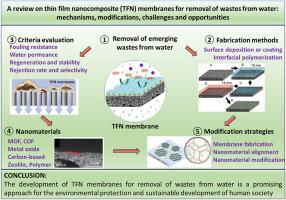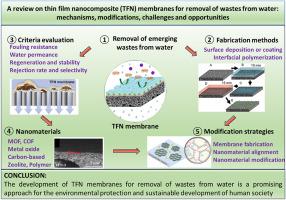Thin-film nanocomposite (TFN) membrane technologies for the removal of emerging contaminants from wastewater
IF 9.7
1区 环境科学与生态学
Q1 ENGINEERING, ENVIRONMENTAL
引用次数: 0
Abstract
Thin film nanocomposite (TFN) membranes, consisting of nanoparticles and polyamide barriers are an efficient separation tool for removal emerging wastes from water. In the last decade, conventional and advanced approaches for TFN membrane preparation have been developed. In addition, nanomaterials with low fouling tendency, high chemical resistance and versatile pore/channel structures are applied in the field of TFN membrane fabrication. Here, the state-of-the-art developments of TFN membranes for water treatment are comprehensively reviewed. Recent advances in the design/fabrication/modification of nanomaterials as well as the functionalization/optimization of TFN membranes are discussed in detail. The capital and operational expenditures (CAPEX and OPEX) analysis, the technological readiness level (TRL) and the patent-related status of the TFN membranes are then overviewed. It is found that most of the reported TFN membranes have been validated in a laboratory setting (TRL 4) and are gradually being validated/demonstrated in relevant environment (TRL 5/6). But, as far as we can see, translation of these researches to industry is yet to come since we found no report of associated patent licensing or startup creation. Therefore, the challenges and limitations of TFN membranes at the current stage are discussed, possible solutions are presented, and suggestions for future research on TFN membranes for water treatment are outlined.


用于去除废水中新出现的污染物的薄膜纳米复合(TFN)膜技术
由纳米颗粒和聚酰胺屏障组成的薄膜纳米复合(TFN)膜是一种高效的分离工具,可去除水中的新兴废物。在过去十年中,人们开发出了传统和先进的 TFN 膜制备方法。此外,具有低结垢倾向、高耐化学性和多孔/通道结构的纳米材料也被应用于 TFN 膜的制备领域。本文全面回顾了用于水处理的 TFN 膜的最新发展。详细讨论了纳米材料设计/制造/改性以及 TFN 膜功能化/优化方面的最新进展。然后概述了 TFN 膜的资本和运营支出(CAPEX 和 OPEX)分析、技术就绪水平(TRL)和专利相关状况。结果发现,大多数已报道的 TFN 膜已在实验室环境中得到验证(TRL 4),并正在相关环境中逐步得到验证/演示(TRL 5/6)。但是,就我们所见,这些研究尚未转化为产业,也没有相关专利许可或初创企业的报告。因此,我们讨论了现阶段 TFN 膜所面临的挑战和局限性,提出了可能的解决方案,并概述了未来水处理 TFN 膜研究的建议。
本文章由计算机程序翻译,如有差异,请以英文原文为准。
求助全文
约1分钟内获得全文
求助全文
来源期刊

Journal of Cleaner Production
环境科学-工程:环境
CiteScore
20.40
自引率
9.00%
发文量
4720
审稿时长
111 days
期刊介绍:
The Journal of Cleaner Production is an international, transdisciplinary journal that addresses and discusses theoretical and practical Cleaner Production, Environmental, and Sustainability issues. It aims to help societies become more sustainable by focusing on the concept of 'Cleaner Production', which aims at preventing waste production and increasing efficiencies in energy, water, resources, and human capital use. The journal serves as a platform for corporations, governments, education institutions, regions, and societies to engage in discussions and research related to Cleaner Production, environmental, and sustainability practices.
 求助内容:
求助内容: 应助结果提醒方式:
应助结果提醒方式:


